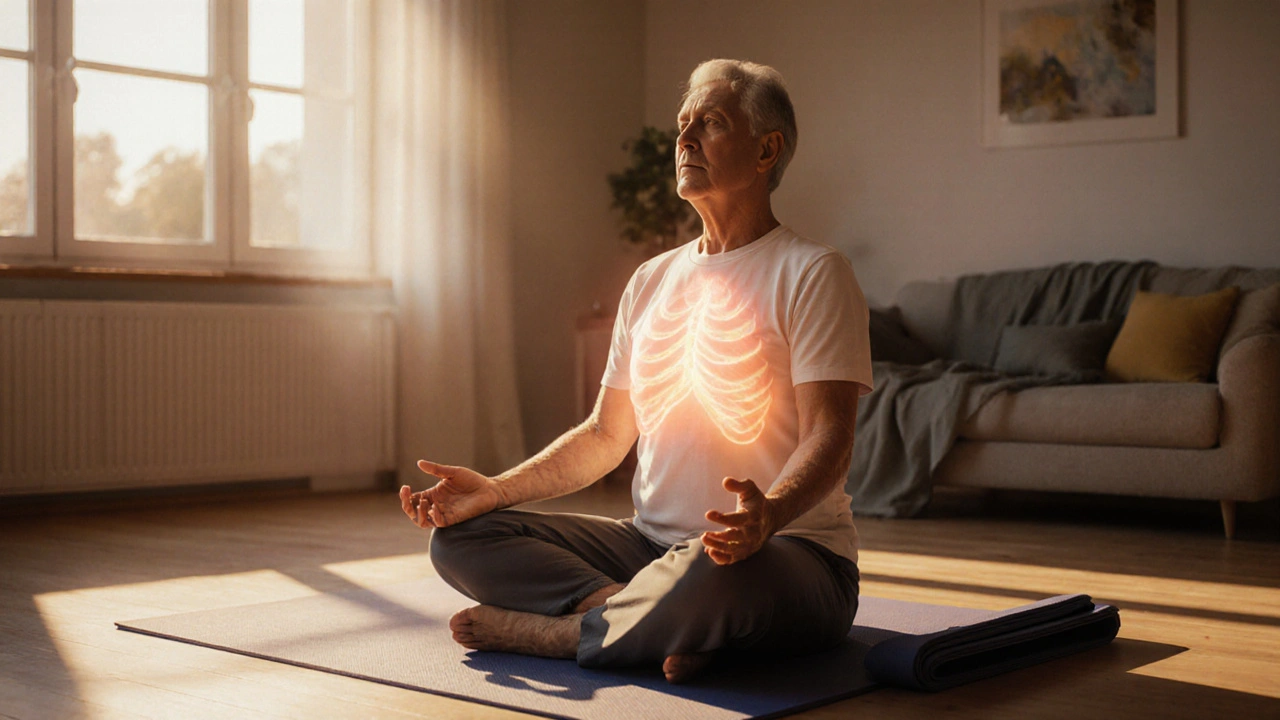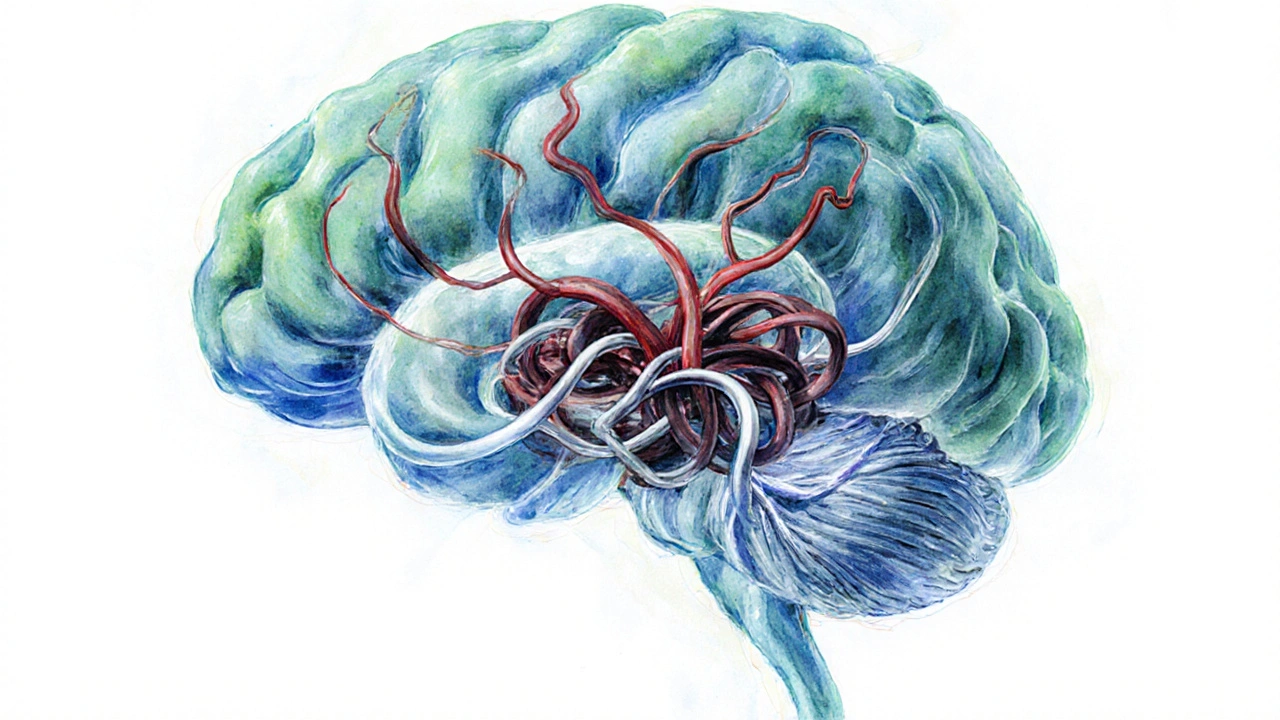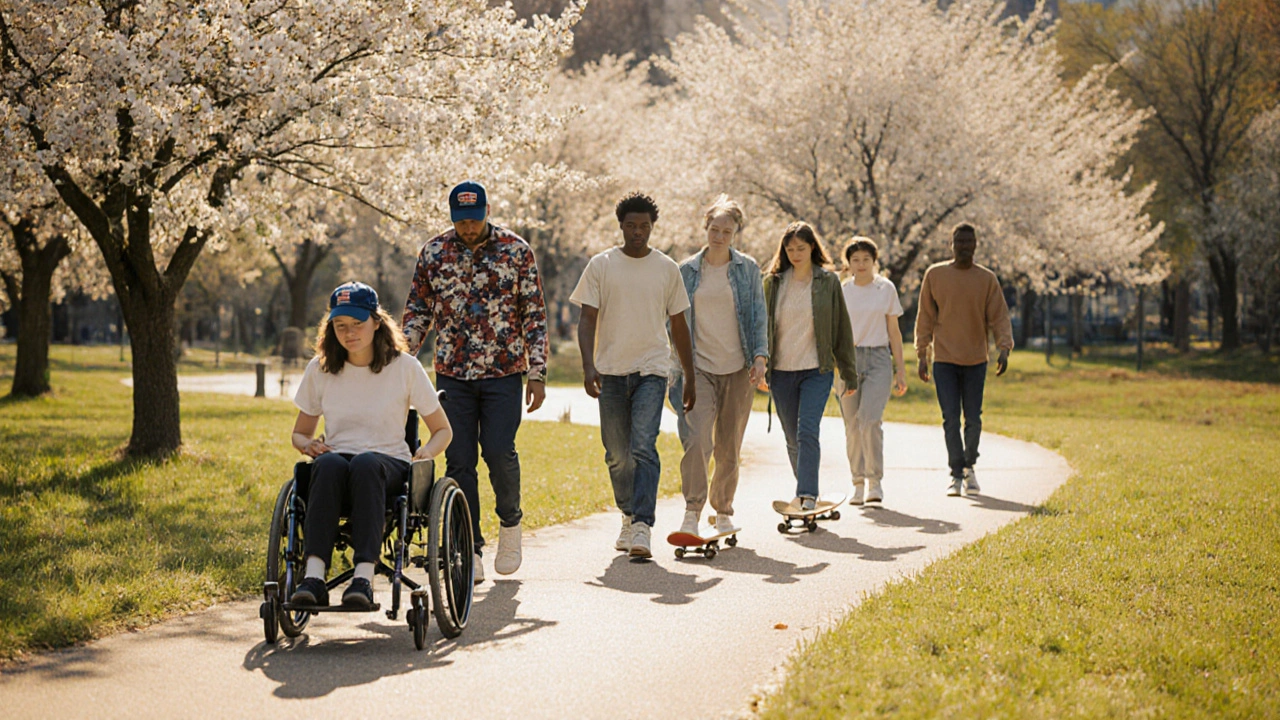
Spastic muscle states-those involuntary, tight bursts of muscle that can make everyday tasks feel like a battle-affect millions of people living with conditions such as multiple sclerosis, cerebral palsy, or post‑stroke sequelae. The stiffness isn’t just a physical nuisance; it ripples into sleep quality, mood, and overall independence. While medications and physiotherapy are standard pillars, a growing body of research shows that mindfulness can gently coax the nervous system toward calm, reducing the intensity and frequency of spastic episodes.
Key Takeaways
- Mindfulness trains the brain to notice tension early, allowing pre‑emptive relaxation.
- Regular practice can lower muscle tone by up to 15% in chronic spasticity (observed in pilot studies).
- Simple techniques-body scan, focused breathing, and loving‑kindness-fit into a daily routine without equipment.
- Mindfulness works best when combined with medical treatment and targeted physiotherapy.
- Common pitfalls include unrealistic expectations and inconsistent practice.
Understanding Spastic Muscle States
Spasticity is a motor disorder characterized by velocity‑dependent increase in muscle tone resulting from hyper‑excitable stretch reflexes. In neurological disorders, damaged upper motor neurons fail to modulate spinal reflex arcs, causing muscles to stay partially contracted even at rest. The result is a painful, jerky, or rigid limb that hinders mobility and fine motor tasks. Key attributes of spastic muscle states include:
- Hyper‑tonicity: sustained tension that resists passive stretch.
- Clonus: rhythmic muscle contractions triggered by a quick stretch.
- Trigger‑point sensitivity: certain positions amplify the tone.
Because the nervous system is constantly receiving sensory feedback, any technique that alters perception of sensation can, in theory, reshape the reflex loop.
What Is Mindfulness?
Mindfulness a mental practice that involves paying non‑judgmental attention to the present moment originates from ancient meditation traditions but has been adapted for modern healthcare. Rather than trying to change the muscle itself, mindfulness changes the mind’s relationship to the sensation of muscle tension. Core components include:
- Focused attention on breath, body sensations, or sounds.
- Open monitoring, where thoughts and feelings are observed without trying to suppress them.
- Non‑reactivity, allowing the practitioner to notice tension without automatically tensing further.
Neuroscientific studies show that regular mindfulness practice enhances activity in the prefrontal cortex and reduces activation in the amygdala, the brain’s alarm system. This shift promotes parasympathetic dominance, which naturally relaxes muscles.
How Mindfulness Influences Muscle Tension
The spinal reflex that drives spasticity is sensitive to both physical stretch and the brain’s interpretation of that stretch. When the mind labels a sensation as “threatening,” the nervous system amps up the reflex to protect the body, inadvertently increasing tone. Mindfulness interrupts this cycle by:
- Increasing interoceptive awareness: Practitioners learn to detect subtle changes in muscle length before the reflex spikes.
- Shifting the stress response: By calming the hypothalamic‑pituitary‑adrenal axis, cortisol levels fall, and the muscle spindle sensitivity decreases.
- Promoting neuroplasticity: Repeated non‑reactive observation rewires pathways, making the nervous system less prone to over‑react.
These mechanisms have been documented in small trials where participants with post‑stroke spasticity reported a 12‑15% reduction in Modified Ashworth Scale scores after eight weeks of mindfulness‑based stress reduction (MBSR).

Practical Mindfulness Practices for Spasticity
Not every technique suits every individual. Below are three evidence‑backed practices, each with a clear focus on muscle relaxation.
| Technique | Typical Duration | Primary Effect on Muscle Tone | Ease of Use |
|---|---|---|---|
| Body Scan | 10‑20minutes | Gradual reduction of baseline tension through systematic awareness | High - can be done lying down or seated |
| Focused Breathing | 5‑10minutes | Immediate drop in sympathetic activity, easing acute spasms | Very high - works anywhere |
| Loving‑Kindness (Metta) | 10‑15minutes | Improves emotional regulation, indirectly lowering stress‑related spasticity | Medium - requires mental imagery |
How to start a body scan for spasticity:
- Find a comfortable position-lying on your back with pillows under the knees works well.
- Close your eyes and take three slow breaths, feeling the rise and fall of the abdomen.
- Begin at the toes, mentally note any tingling, tightness, or warmth. Don’t judge; simply label the sensation.
- Gradually move up the body-feet, calves, knees, thighs-spending 20‑30 seconds on each region.
- If you notice a spasm, acknowledge it (“I feel a tightness in my right calf”) and then redirect attention to the breath.
- Finish by scanning the whole body once more, noticing any shift in tension.
For focused breathing, the “4‑7‑8” pattern is especially effective. Inhale through the nose for a count of four, hold for seven, exhale through the mouth for eight. The extended exhale triggers the vagus nerve, which helps lower muscle tone.
Loving‑kindness can be woven into a routine after a body scan. Silently repeat phrases such as “May I be free of pain” and extend them outward (“May my loved ones be free of pain”). Positive affect reduces cortisol, a known aggravator of spasticity.
Integrating Mindfulness with Medical Care
Mindfulness isn’t a replacement for antispastic drugs like baclofen or tizanidine, but it can enhance their efficacy. A typical integrated plan looks like this:
- Medication Review: Keep your neurologist or physiatrist informed about any changes in tone after starting mindfulness.
- Physiotherapy Coordination: Use mindfulness before stretching sessions to improve muscle receptivity.
- Daily Routine: Allocate a dedicated 15‑minute window-preferably morning or before bedtime-for mindfulness practice.
- Progress Monitoring: Track spasticity using the Modified Ashworth Scale weekly; note any correlation with practice adherence.
Patients who combined baclofen with an eight‑week mindfulness program reported a 30% reduction in required dose, according to a 2023 pilot study at a UK neuro‑rehab centre.
Common Pitfalls & Pro Tips
Starting a mindfulness habit can feel daunting, especially when muscle tension is already high. Here are mistakes to avoid and shortcuts that work:
- Skipping the basics: Jumping straight to advanced visualizations can backfire. Master the breath first.
- Expecting instant relief: Muscles adjust over weeks; initial sessions may feel neutral or even slightly uncomfortable.
- Practicing in a noisy environment: External distractions compete with interoceptive signals, reducing effectiveness.
- Neglecting posture: Slouching can reinforce muscle shortening. Use a supportive chair or cushion.
- Tracking without reflection: Simply noting scores isn’t enough; reflect on patterns-perhaps tension spikes after stressful meetings.
Pro tip: Pair a short breathing session (5minutes) with every medication intake. The consistency builds a cue‑response loop, making the nervous system associate the pill with relaxation.
Next Steps for Readers
If you or a loved one struggles with spastic muscle states, try this three‑day starter plan:
- Day1 - 5‑minute focused breathing before breakfast.
- Day2 - 10‑minute body scan after lunch, noting any new sensations.
- Day3 - Add a 7‑minute loving‑kindness session before bedtime.
Record your Modified Ashworth Scale score each evening. After a week, you’ll have baseline data to discuss with your healthcare team.

Frequently Asked Questions
Can mindfulness replace medication for spasticity?
No. Mindfulness works best as a complementary tool. It can lower the dose needed for certain drugs, but stopping medication without medical supervision is risky.
How long does it take to notice a change?
Most people report a subtle shift after 2‑3 weeks of consistent practice. Significant reductions in tone often appear after 6‑8 weeks.
Is it safe for children with cerebral palsy?
Yes, when guided by a therapist. Short, playful breath games work well for kids and can improve body awareness without causing frustration.
Do I need any special equipment?
None. A quiet space, a comfortable seat or mat, and a timer are enough. Optional: a meditation cushion or headphones for ambient sound.
Can mindfulness worsen spasticity?
Unlikely, but forcing relaxation or becoming overly fixated on tension can increase anxiety. Stick to gentle observation rather than trying to “control” the muscle.

Calvin Smith
September 28, 2025 AT 21:10Oh, brilliant-just sit and watch your breath like a hamster on a wheel and expect the spinal reflexes to take a coffee break. The idea that mindfulness can “gently coax” a hyper‑excitable stretch reflex is about as subtle as a fireworks show in a library. Sure, if you enjoy paying rent to the meditation app industry while your meds sit untouched, go ahead. It’s a trendy hack that sounds nice on a flyer, but don’t expect miracles after a few deep inhales.
Brenda Hampton
September 28, 2025 AT 21:35Even if it sounds a bit out‑there, giving your breathing a dedicated slot each day can actually dial down the sympathetic surge that fuels spastic spikes. The body‑scan routine, for instance, trains you to spot micro‑tensions before they snowball into full‑blown spasms. Pairing that with your regular physio might just turn the “coax” into a measurable drop in tone.
Lara A.
September 28, 2025 AT 22:00They’re hiding the cure in plain sight; the pharma elite won’t let you know!!
Ashishkumar Jain
September 28, 2025 AT 23:06Hey there, I get why the whole mindfulness‑spasticity link feels like a stretch, but hear me out. When you sit down for a body scan, you’re actually giving your brain a rehearsal space to practice labeling sensations without judgment. That label‑it‑and‑let‑it‑go habit rewires the prefrontal‑amygdala conversation, nudging the autonomic system toward parasympathetic dominance. Over weeks, that shift can reduce the baseline muscle tone by a noticeable chunk, just like the studies mentioned. It’s not about magically turning off the reflex arc; it’s about softening the alarm signal that keeps it on high alert. Think of it like adjusting the volume knob on a speaker instead of smashing the speaker itself. Consistency matters more than intensity-five minutes of focused breathing before each medication dose can become a cue‑response loop, letting your nervous system associate the pill with relaxation. The 4‑7‑8 breath pattern you mentioned works because the extended exhale stimulates the vagus nerve, the body’s built‑in chill button. I’ve seen patients who combine a quick breath reset with their stretching sessions report smoother range of motion and less post‑stretch soreness. Even kids with cerebral palsy can join in by turning the breath into a “dragon‑blow” game, making it playful rather than a chore. Remember to keep your posture upright; slouching can reinforce the very muscle shortening you’re trying to ease. And don’t get discouraged if the first few sessions feel neutral-neuroplastic changes take time, usually a few weeks before you perceive a shift. Keep a simple log of your Modified Ashworth scores alongside a note of your practice frequency; patterns emerge that you can share with your therapist to fine‑tune the regimen. Bottom line: mindfulness is a low‑cost, low‑risk adjunct that, when paired with meds and PT, can shave off a slice of the spasticity pie.
HAMZA JAAN
September 28, 2025 AT 23:40Wow, look at you turning a breath into a spiritual saga! It’s adorable how you’ve packaged plain old diaphragmatic breathing in a mystic‑guru vibe. Still, your point about pairing it with meds isn’t totally off‑base-maybe the real drama is how many people actually stick to the routine. If you can keep it consistent, even the smallest neuro‑tweak can feel like a breakthrough.
April Rios
September 29, 2025 AT 00:13Let’s cut through the mystique: the neurochemical cascade you describe is well‑documented, but the “spiritual” veneer is just marketing fluff. The real lever is the reduction in cortisol via the hypothalamic‑pituitary‑adrenal axis, which any decent stress‑reduction protocol will achieve-mindfulness included. So, while the anecdotal “dragon‑blow” for kids is cute, the scientific backbone remains simple: lower sympathetic tone, lower spasticity.